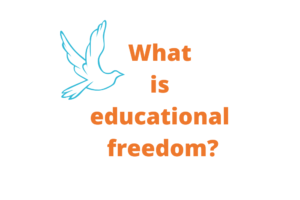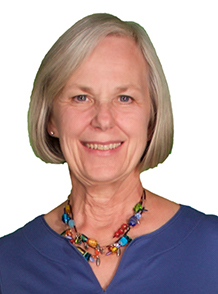
My schooling consisted of six elementary schools, one junior high, one high school, three colleges and two Montessori institutes. I’ve attended schools in Oklahoma, Arkansas, Oregon, Ohio, Washington, D.C, Germany, and Costa Rica.
The similarities in all these schools are striking in the fact that the teacher lectured at the front of the room; there were blackboards, bulletin boards, textbooks. All students worked at the same pace determined by the teacher. Tests and grades were given.
Until I entered college, I had no choice for the public school I attended as admission was based on living in a certain attendance zone. For my K-12 years there were no private schools, only the local Catholic schools.
The thought of having the freedom to go to another school never crossed my mind until I was in German high school and wanted something different, but there were no alternatives.
When my children were toddlers, over 40 years ago, I found Montessori education, and the concept of school choice for elementary school became important to me.
Fortunately that choice was available to our family because we had the resources to send our daughters to a private Montessori school, as well as to homeschool, and eventually start a Montessori school.
Once I discovered how schooling might be different, I’ve wanted all families to have the ability to choose the schools they think best for their children.
All children deserve educational freedom.
What do I mean by educational freedom?
Educational freedom exists when there is school choice for every child in a full free educational market.
Let’s look at some of these terms:
School choice
School choice is the process of allowing every family to choose the K-12 educational options that best fit the needs of their children. Each child is unique, and every child learns differently. That is why school choice is important. While some children might succeed in their designated public school, others might find a better learning environment with charter, magnet, online, private, home schooling or some other form of education.
“Education markets have consistently done a better job than state monopolies of serving both our individual needs and our communal goals. Yet all market-inspired education reforms are not intrinsically or uniformly effective. They can succeed only to the extent that they support the conditions for a thriving education market and ensure that all families have access to that market.”
Andrew J. Coulson
Full free educational market
A full free educational market requires the following:
- Parental choice of school
- Direct parental financial responsibility
- Freedom for educators to establish different types of schools
- Competition among educators
- Profit motive for educators
- Universal access
Parental choice of school refers to parents being able to choose any school, private or public for their children. Today in most public school districts families must send their children to the school in their attendance zone. In the case of magnet and charter schools there is usually a lottery system in place with many, if not most, applicants being denied due to space limitations. Online schools are able to scale their attendance to meet demand. Homeschooling in some states is not allowed or carries onerous requirements such as the parent must be a certified teacher in that state.
Parents have direct financial responsibility for their children’s education when they have a voice about what is taught and how the school is run.
When parents have a financial stake, if the school doesn’t meet their family’s requirements, they are free to leave and find another school.
Even though public schools are funded with taxpayer dollars, school rules and regulations are made by a bureaucratic group that are not particularly responsive to parents’ requests.
Vouchers and tuition tax credits along with educational savings accounts (ESA) are giving parents, today, the ability to direct taxpayer funds for their children’s education. Each of these three financial vehicles have their pros and cons in terms of non-interference of government regulations on how funds can be spent.
Freedom for educators to establish different types of schools. One type or size of school could never fit the educational needs of all the children. Market forces would allow the development of various educational opportunities allowing parents to create or choose the type of education they desire.
Competition among educators fuels innovation in all aspects of running a school including curriculum, budget, teacher training, and more.
Profit motive for educators is also key to market education. A profit motive creates incentives to start or replicate outstanding schools.
Universal access means the playing field is leveled so that all children have choices of where they go to school and each family has an opportunity to apply to any school regardless of location and cost.
Educational freedom is an idea whose time has come.
Today over half of our states have passed legislation to create school choice options including educational savings accounts, tuition tax-credits and/or vouchers.
Many states have pending legislation or voter initiatives that could make a difference for our children and their future.
I invite you to learn more about this idea of educational freedom, or full free market education.
Below you’ll find links to a video series, an online library about school choice, two national school choice organizations, a school choice guide, along with how to find a school choice group in your state.
The late Andrew Coulson created a three-part PBS series, School Inc., that originally aired in 2017. The stories that Andrew shares with us are fresh and important for our children.
In only three hours Andrew Coulson takes you on a historical and global journey explaining how our present educational system came to be and what innovations other countries have made.
Cato Institute’s online library offers many edifying articles on educational freedom here:
Visit these organizational websites to find out about school choice across the United States.
EdChoice
American Federation for Children
Download and read the 2023 ABCs of School Choice Guide from EdChoice.
Search on the terms educational freedom and your state name to connect directly with state organizations supporting school choice.
For example, right now there is a voter initiative in Oregon for November 2024.
Find out more here: https://educationfreedomfororegon.com
Thank you for helping children and families have a voice about school choice.
Maren




Here is a short video that explains why school choice helps education overall.
https://www.prageru.com/video/why-public-schools-should-want-school-choice/
The Cato Institute posted an article on its blog page today about universal school choice not being a panacea.
There are so many factors that come into creating educational freedom, and there is no way that one type of school could make everyone happy.
Perhaps it is that trying to make everyone fit into one type of program that creates the power struggles we see in education.
I invite you to read this article to understand what school choice can and cannot do.
https://www.cato.org/blog/universal-school-choice-good-its-not-panacea/